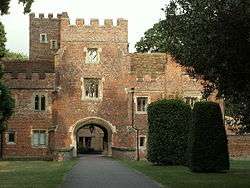Buckden Towers
| Buckden Towers | |
|---|---|
| Near Buckden, Cambridgeshire in England | |
|
Entrance to Buckden Towers | |
 Buckden Towers Shown within Cambridgeshire | |
| Coordinates | 52°17′39″N 000°15′09″W / 52.29417°N 0.25250°WCoordinates: 52°17′39″N 000°15′09″W / 52.29417°N 0.25250°W |
| Type | Fortified manor house |
| Site information | |
| Open to the public | Grounds open regularly |
| Condition | Used as a Christian retreat |
| Site history | |
| Built | 1175 |
| In use | 1175-Present |
| grid reference TL192677 | |
Buckden Towers, formerly known as Buckden Palace, is a 12th-century fortified manor house, located on High Street, Buckden, Cambridgeshire, England.
History
Although it is often stated as being built in the 15th century, the first (wooden) Palace was actually built in the late 12th century, when records show it as being used to house the Bishops of Lincoln. Subsequently, the wooden structure was replaced by more substantial buildings and a tall brick tower was added in 1475, protected by walls and a moat, and surrounded by an outer bailey. Parts of the complex were demolished in 1832 on the orders of the Ecclesiastical Commissioners. The Victorian House now present on the site was built in 1872.
The Claretian Missionaries were given the site by the Roman Catholic Bishop of Northampton in 1956. Initially it was used a Junior Seminary carrying out the preliminary training of 11- to 18-year-olds aspiring to become Claretian Missionary priests or brothers. The Junior Seminary closed in July 1965. Since then the Towers complex has been developed by the Claretians as a Retreat and Conference Centre. Also located on the site is the Catholic Parish Church of St Hugh of Lincoln, which stands on the site of the great chamber of the medieval palace and was originally built as the chapel for the Junior Seminary. The grounds, but not the buildings, of the Towers are open to visitors at all reasonable times but dogs are not permitted.
It is a scheduled monument and a Grade I listed building.[1]
Little now remains of the bishops' moated palace except the great tower, the inner gatehouse, part of the battlemented wall, which used to surround the inner court within the moat, and the outer gate and wall. On 16 July 1551, Henry, Duke of Suffolk and his brother Lord Charles died here from the sweating sickness. They had come to Buckden to avoid the sickness at Cambridge.[2]
In the 1630s Bishop Williams held state at Buckden, entertaining his neighbours with lavish displays of hospitality.
The antiquary Edward John Rudge published a history, Illustrated and Historical Account of Buckden Palace, in 1839.[3]
Notable visitors
- Henry III in 1248
- Edward I in 1291
- Richard III in 1483
- Lady Margaret Beaufort (mother of Henry VII) in 1501
- Queen Katherine of Aragon – resided here from July 1533 to May 1534. The Palace of Buckden is probably best known for holding Henry VIII’s first Queen, Katherine of Aragon during the King’s Great Matter, from July 1533 until May 1534 until she was transferred a few miles away to Kimbolton Castle, where she died in 1536. She would eventually be buried just north of both Buckden and Kimbolton at Peterborough Cathedral.[4]
- Henry VIII & Catherine Howard in 1541. They stayed at Buckden Palace in 1541, during a summer tour that the King and Queen took of England before her coronation. It was during this tour that Catherine would be accused of committing adultery with Thomas Culpeper which led to her beheading for treason in 1542.[4]
- James I in 1619
- Prince Regent in 1814
- William Barlow (bishop of Lincoln) – buried there
See also
Bibliography
- Pettifer, Adrian. (2002) English Castles: a Guide by Counties. Woodbridge, UK: Boydell Press. ISBN 978-0-85115-782-5.
Footnotes
- ↑ "Buckden Towers", Gatehouse website, accessed 21 April 2011.
- ↑ Strype, John, Ecclesiastical Memorials, vol. 2 part 1, Oxford (1822), 491
- ↑
 Woodward, Bernard Barham (1897). "Rudge, Edward". In Lee, Sidney. Dictionary of National Biography. 49. London: Smith, Elder & Co.
Woodward, Bernard Barham (1897). "Rudge, Edward". In Lee, Sidney. Dictionary of National Biography. 49. London: Smith, Elder & Co. - 1 2 Buckden Palace Page on Cambridge Military History Website, accessed 10 January 2015
External links
| Wikimedia Commons has media related to Buckden Towers. |
- The Claret Centre
- Friends of Buckden Towers
- Gatehouse Gazetteer record for Buckden Towers, containing a comprehensive bibliography.
- Buckden Village
- Detailed historic record for Buckden Towers
- The RC Parish of St Hugh of Lincoln Buckden and St Joseph in St Neots
- The Palace of Buckden, Cambridge Military History Website
